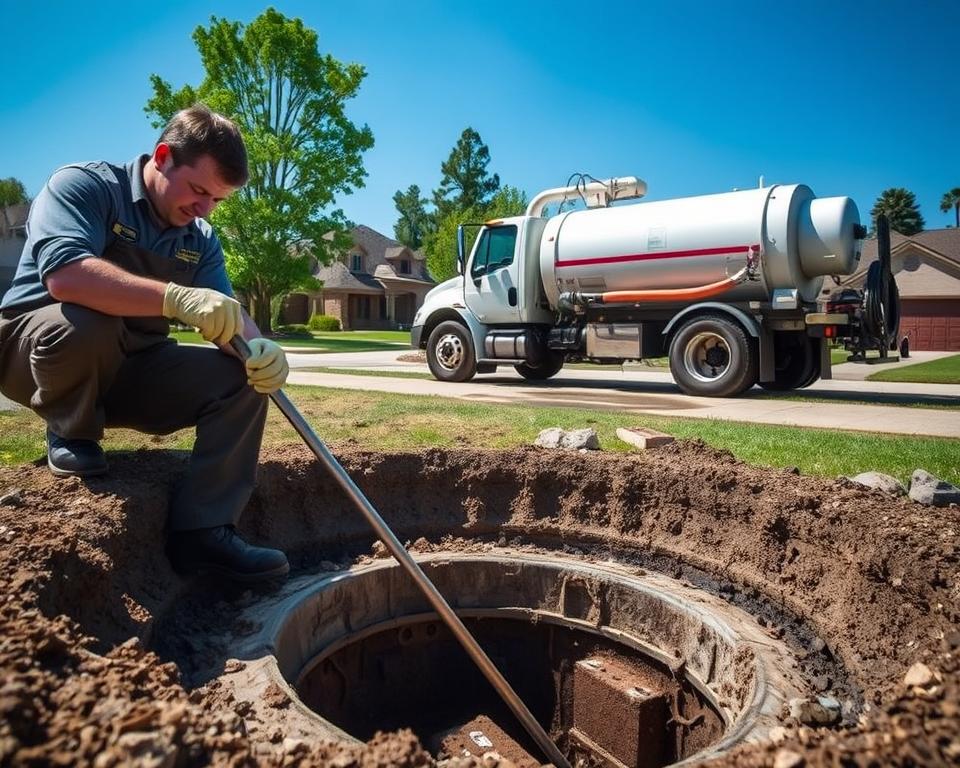Sewage Ejector Device: Essential Guide & Advice
Did you know that nearly 60 million households in the United States use wastewater treatment systems for sewage management? The septic ejector pump is a vital part of these systems. It moves wastewater from the septic tank to the effluent field or the municipal sewage main. This pump is essential for homes situated lower than the level of the sewage lines, avoiding backups and guaranteeing proper drainage.
This manual will help you understand how septic ejector pumps work. It will also explain how to pick the right pump for your home, the best way to install it, and how to maintain it in good working order. We’ll also talk about signs that your pump might need fixing. With guidance from experts and reliable sources like All In Site Services, we aim to make managing your home’s wastewater system simpler.
Understanding a Sewage Ejector Pump?
A sewage lift pump is key for homes not connected to city sewers. It’s designed to elevate and transfer sewage and wastewater, even solid waste that regular pumps can’t handle. Powered by a motor, it pushes waste from the septic tank to the drainage field or city sewers, keeping things sanitary.
How Septic Ejector Pumps Work
Sewage ejector pumps are great at moving both solids and liquids. When the septic tank gets full, the pump activates. It uses pressure to force sewage up, even countering gravity. This is especially useful for homes with basements or low plumbing.
It makes sure wastewater flows quickly, avoiding backups and maintaining cleanliness.
Comparison of Ejector Pumps and Other Pumps
Septic ejector pumps are distinct compared to other pumps, each with its own purpose in handling wastewater. Here’s how they contrast:
| Type of Pump | Purpose | Solid Handling Capability |
|---|---|---|
| Waste Ejector Pump | Transfers sewage from septic tanks to drainage systems | Up to 2 inches solids |
| Sewage Pump | Handles wastewater and sewage | Up to 2 inches solids |
| Discharge Pump | Transfers lighter wastewater and effluent | Some small solids |
| Drain Pump | Removes water from basements and low areas | Handles minor debris only |
This chart illustrates how septic ejector pumps stand out from waste and discharge pumps. They’re effective in managing solid waste. Knowing these variations helps picking the appropriate pump for your wastewater requirements.
Choosing the Correct Waste Ejector Pump for Your System
Choosing the right 24 hour septic pumping near me is key to a well-working system. It’s essential to know what your system requires for the best performance. Looking at different factors can assist in a good choice.
Factors to Consider When Selecting a Pump
When picking a septic system pump, consider these things:
- Total Dynamic Head (TDH): This tells you how high the pump must lift the waste. A higher TDH means you require a more powerful pump.
- Flow Capacity: Figure out how much waste you need to pump in a certain time. This helps pick a pump that can handle the load.
- Basin Size: Make sure your basin is big enough, at least 18×30 inches for homes. A bigger basin helps the pump’s efficiency.
Common Types of Ejector Pumps
Knowing about the different ejector pumps can assist in making a informed choice:
| Pump Type | Description | Ideal Application |
|---|---|---|
| Grinder Pump | Engineered to shred solids into smaller particles for simplified transfer. | Suitable for areas with high solid content in sewage. |
| Elevator Pump | Processes larger volumes of water and solids efficiently. | Perfect for large home systems or commercial applications. |
Brands like Zoeller and Liberty Pumps provide many models for different requirements. Doing your homework can help you find a pump that works well for you. This results in a more effective and dependable sewage system.
Tips for Installing a Septic Ejector Pump
Setting up a waste lift pump is a complex process. It demands meticulous planning and execution for optimal performance. Following important steps and avoiding common pitfalls can stop future issues and improve your system’s efficiency.
Step-by-Step Installation Process
- Select the pump’s placement, following local regulations and ensuring easy maintenance access.
- Prepare a stable, even base for the pump’s stability.
- Attach the pump to the septic tank and drainage system firmly.
- Install electrical components following the pump’s requirements for effective sewage pump installation.
- Examine the system carefully before sealing connections or sealing access points.
Common Pitfalls to Avoid During Installation
- Improper pump sizing can lead to inefficiencies and increased wear.
- Not sealing connections correctly may cause leaks, affecting the system.
- Overlooking the pump’s electrical requirements can cause failures.
- Neglecting ventilation requirements can worsen odors and pressure issues.
- Not following the manufacturer’s guide can lead to missing important specifications.
| Common Issues | Effect | Solution |
|---|---|---|
| Incorrect sizing | Reduced pump efficiency and increased energy costs | Refer to specifications for required capacity |
| Leaks due to poor sealing | Contaminated water and odor issues | Apply reliable sealing materials and techniques |
| Wiring issues | Frequent breakdowns of the pump | Verify electrical requirements before installation |
| Poor ventilation | Odor buildup and system pressure issues | Provide adequate venting in lift station pump installation |
| Insufficient testing | Overlooking issues before sealing the system | Conduct comprehensive tests pre-installation |
Top Maintenance Tips for Your Sewage Pump
Regular maintenance of your septic ejector pump is key to its long-term performance and reliability. By following effective care routines, you can enhance the pump’s efficiency. Here are some top tips to maintain your pump in optimal condition:
- Inspect the pump biannually for any debris that might block it.
- Look at all electrical connections closely. Damaged wires can cause the pump to fail.
- Ensure the float switch works right. A broken switch can cause backups or overflows.
- Monitor the wastewater levels in the basin. Catching problems promptly can reduce costs on repairs.
- Clean the sump basin often. This prevents debris from affecting the pump’s work.
- Schedule a professional check it as needed. Experts can make sure everything is working right.
Adhering to these steps will not only prolong your sewage pump’s life but also keep it running efficiently. Maintaining septic ejector pump upkeep is essential to avoid unexpected problems and maintain your sewage system running smoothly.
Signs Your Septic Ejector Pump Needs Repair
Identifying when your sewage ejector pump requires fixing is vital to keeping your sewage system functional. Unusual noises from the pump can indicate mechanical issues. This could suggest your sewage pump has problems that need quick action.
If your pump operates intermittently more than usual, it might be overworking. This could mean it can’t handle the system’s demands and needs inspection.
Bad smells near the pump are another significant red flag. These smells can indicate leaks or backups, suggesting the pump is not functioning properly. Seeing sewage backup in your plumbing is a definite sign repairs are necessary. Fixing these issues fast can prevent bigger problems and save you money later.
If your septic ejector pump doesn’t turn on when it should, it could be a serious problem. This could be due to a mechanical or electrical issue. Having it inspected or serviced quickly is crucial. Being quick to act on these signs can prevent big problems and save you money and trouble.



